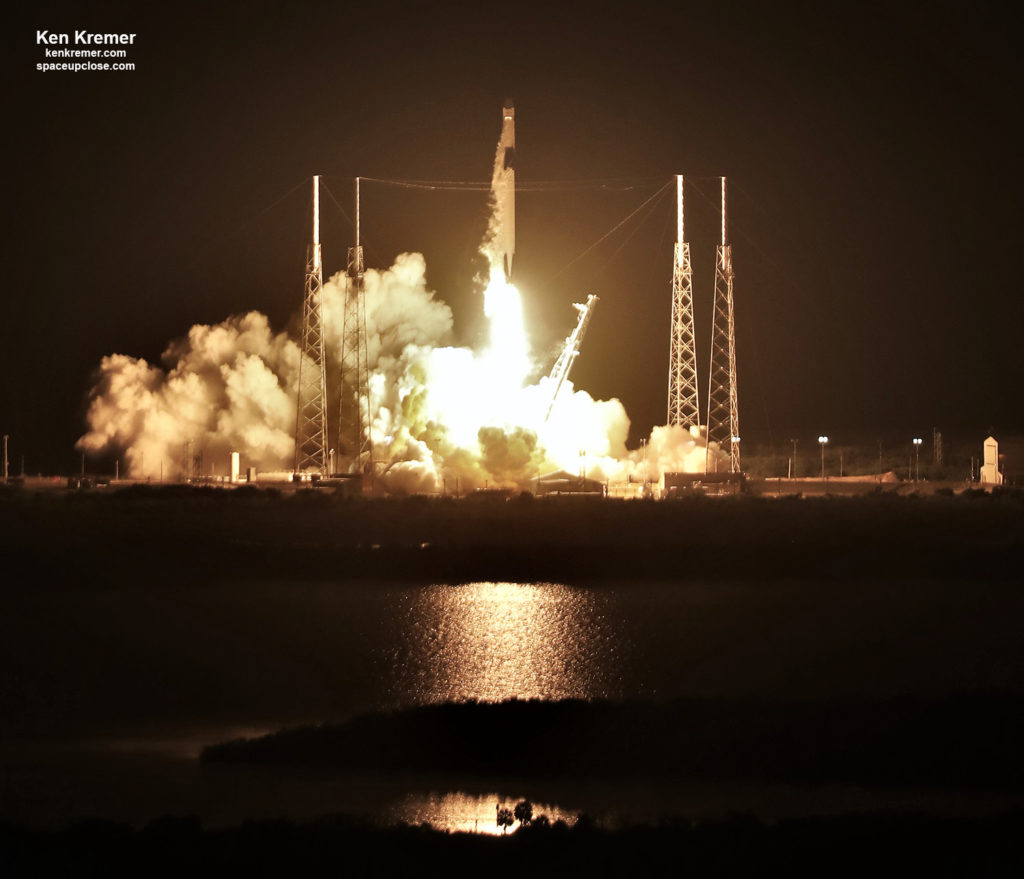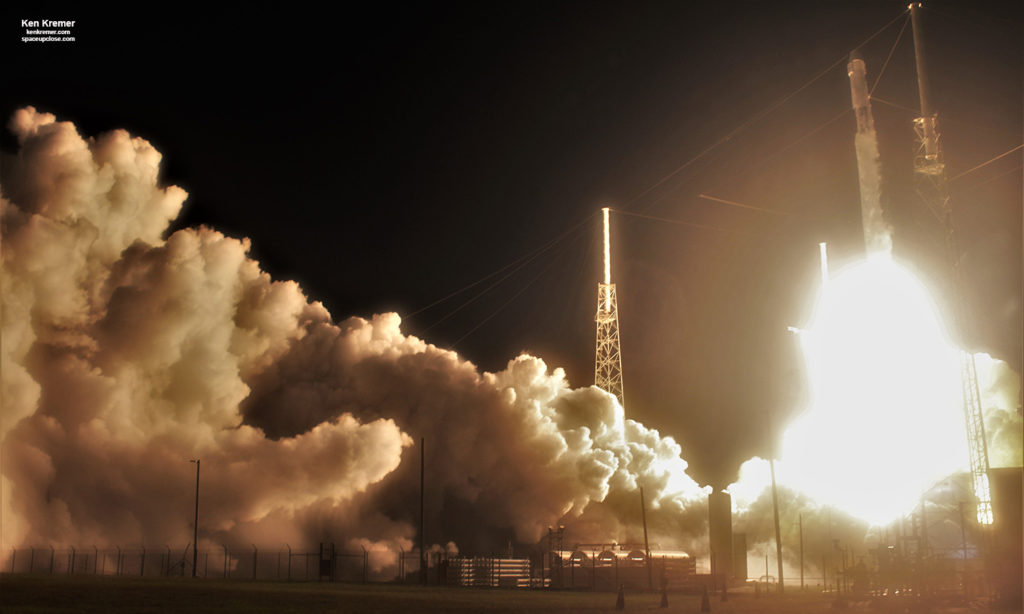 |
Ken
Kremer — SpaceUpClose.com &
RocketSTEM – 6 May 2019
KENNEDY SPACE CENTER, FL – Two days after a stunningly beautiful and
technically flawless middle-of the-night launch atop a commercial SpaceX Falcon 9
rocket Saturday, May 4, the private Dragon resupply craft arrived at the International Space Station
early this morning, Monday, May 6 loaded with approximately 5,500 pounds of
NASA cargo and science investigations.
After Dragon executed a carefully
choreographed series of thruster maneuvers it arrived in the vicinity of the International
Space Station early this morning and was grappled while traveling
over the north Atlantic Ocean by Canadian astronaut David Saint-Jacques of the
Canadian Space Agency and American astronaut Nick Hague of NASA at 7:01 a.m. EDT using the
space station’s robotic arm Canadarm2.
Ground controllers than started the process of
sending commands to begin the robotic installation of the spacecraft on bottom
of the station’s Harmony module by maneuvering it ever closer to the berthing
port.
 |
|
The SpaceX Dragon CRS-17 cargo craft approaches the International Space
Station for a robotic capture on May 6, 2019. Credit: NASA |
Finally the SpaceX Dragon cargo spacecraft was
installed on the Earth-facing port of the Harmony module at 9:32 a.m. EDT while
the station was soaring 254 miles (400 km) over Australia.
By 9:35 a.m. all 16 bolts and latches were
driven home for a hard mate.
berthing activities were covered live on NASA Television.
The SpaceX Falcon 9 successfully blasted off at 2:48 a.m. EDT (0648 GMT) Friday, May 4 with the unpiloted Dragon CRS-17 cargo ship from Space
Launch Complex 40 at Cape Canaveral Air Force Station in Florida bound for the
ISS with almost 3 tons of science investigations and supplies and included research into Earth’s
carbon cycle, numerous biomedical and physical sciences investigations and the
formation of asteroids and comets.
The Falcon 9 CRS-17 launch
marked a great comeback for SpaceX following the hugely disappointing and
devastating static fire test malfunction that completely destroyed the Demo-1 Crew
Dragon spacecraft on April 20 just before Easter Sunday – a big setback that
will undoubtedly force a delay in finally launching astronauts aboard the Demo-2
Crew Dragon spacecraft.
CRS-17 is the 17th
SpaceX resupply mission to the ISS.
As of today there are
six visiting vehicles docked at the ISS including the SpaceX CRS-17 Dragon,
Northrop Grumman’s Cygnus NG-11 space freighter and Russia’s Progress 71 and 72
resupply ships and the Soyuz MS-11 and MS-12 crew ships.
The six person crew multinational
Expedition 59 from the US, Russia and Canada will open hatches later today and
begin unloading the cargo.
The six person Expedition 59 crew comprises astronauts David
Saint-Jacques of the Canadian Space Agency and Anne McClain of NASA; cosmonauts
Oleg Konenenko and Alexey Ovchinin of Roscosmos; and NASA astronauts Nick Hague
and Christina Koch.
CRS-17 will remain at
the station about 1 month. The crew will reload the ship with about 4200 pounds
of science samples, hardware and materials for the return trip to Earth in early
June.
This Dragon is refurbished and recycled and previously flew
on the prior CRS- 12 mission to the station in Aug 2017.
high, 12-foot-diameter Dragon CRS-17 vessel is jam packed with more than 5500 pounds (2500 kilograms) of science experiments,
research hardware, space parts, food water, clothing and more supplies for the six
person Expedition 59 and 60 crews.
The science payload alone amounts to 1601 pounds, 726 kg –
including the two unpressurized cargo payload carried up in the truck and to be
mounted externally: namely NASA’s Orbiting Carbon Observatory-3 (OCO-3) which will measure
levels of carbon dioxide in the atmosphere during its planned 3 year mission and the Space Test Program-Houston 6 (STP-H6).
Overall the CRS-17 manifest includes:
pounds / 1,517 kilograms
From NASA: Here’s some of the science arriving at
station
Scientists are using a new technology
called tissue chips, which could help predict the effectiveness of
potential medicines in humans. Fluid that mimics blood can be passed through
the chip to simulate blood flow, and can include drugs or toxins. In
microgravity, changes occur in human health and human cells that resemble accelerated
aging and disease processes. This investigation allows scientists to make
observations over the course of a few weeks in microgravity rather than the
months it would take in a laboratory on Earth.
The Hermes facility allows scientists to
study the dusty, fragmented debris covering asteroids and moons, called
regolith. Once installed by astronauts on the space station, scientists will be
able to take over the experiment from Earth to study how regolith particles
behave in response to long-duration exposure to microgravity, including changes
to pressure, temperate and shocks from impacts and other forces. The
investigations will provide insight into the formation and behavior of
asteroids, comets, impact dynamics and planetary evolution.
These are just a few of the hundreds of investigations that will help us learn
how to keep astronauts healthy during long-duration space travel and
demonstrate technologies for future human and robotic exploration beyond
low-Earth orbit to the Moon and Mars. Space station research also
provides opportunities for other U.S. government agencies, private industry,
and academic and research institutions to conduct microgravity research that
leads to new technologies, medical treatments, and products that improve life
on Earth.
……
and Crew Dragon mission in lead video:
News Orlando about the SpaceX Crew Dragon testing failure here and the implications
for delay in future Crew Dragon test flights here:
onsite coverage of NASA, SpaceX, ULA, Boeing, Lockheed Martin, Northrop Grumman
and more space and mission reports direct from the Kennedy Space Center, Cape
Canaveral Air Force Station, Florida and Wallops Flight Facility, Virginia.
Stay tuned here for Ken’s continuing Earth and
Planetary science and human spaceflight news: www.kenkremer.com –www.spaceupclose.com – twitter @ken_kremer
– email: ken at kenkremer.com
Dr. Kremer is a research scientist and journalist based in the
KSC area, active in outreach and interviewed regularly on TV and radio about
space topics.
Ken’s photos are for sale and he is available for lectures and outreach events




